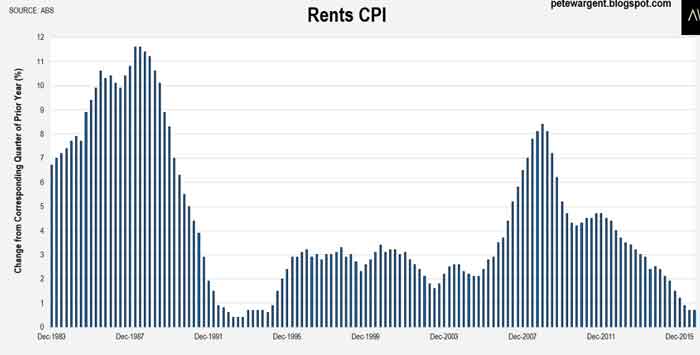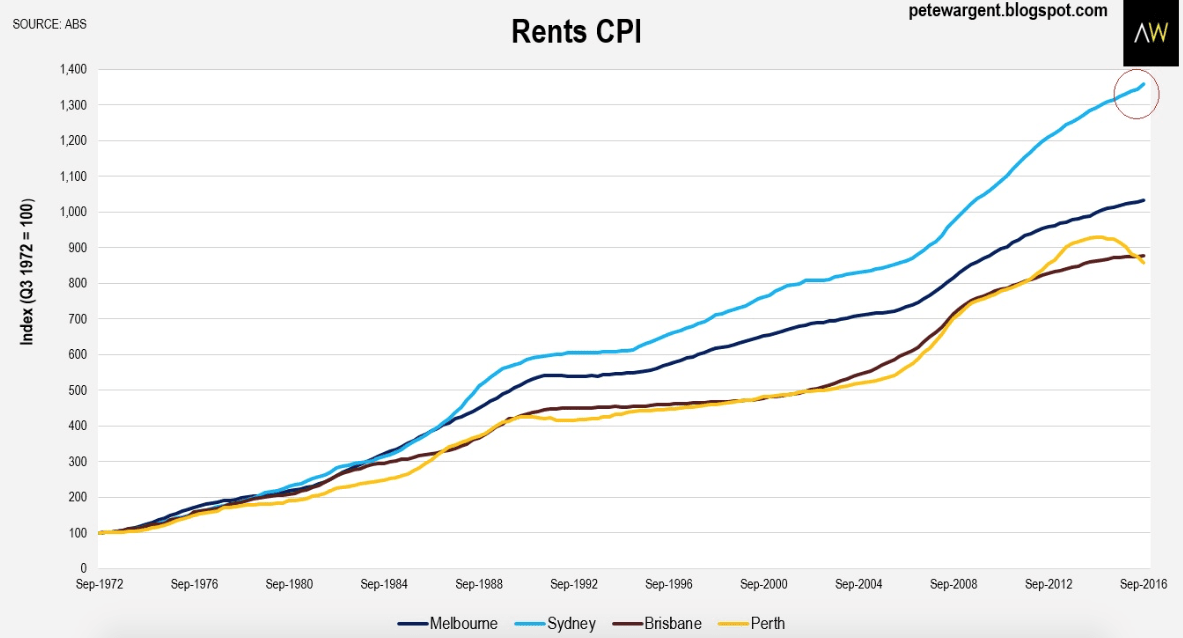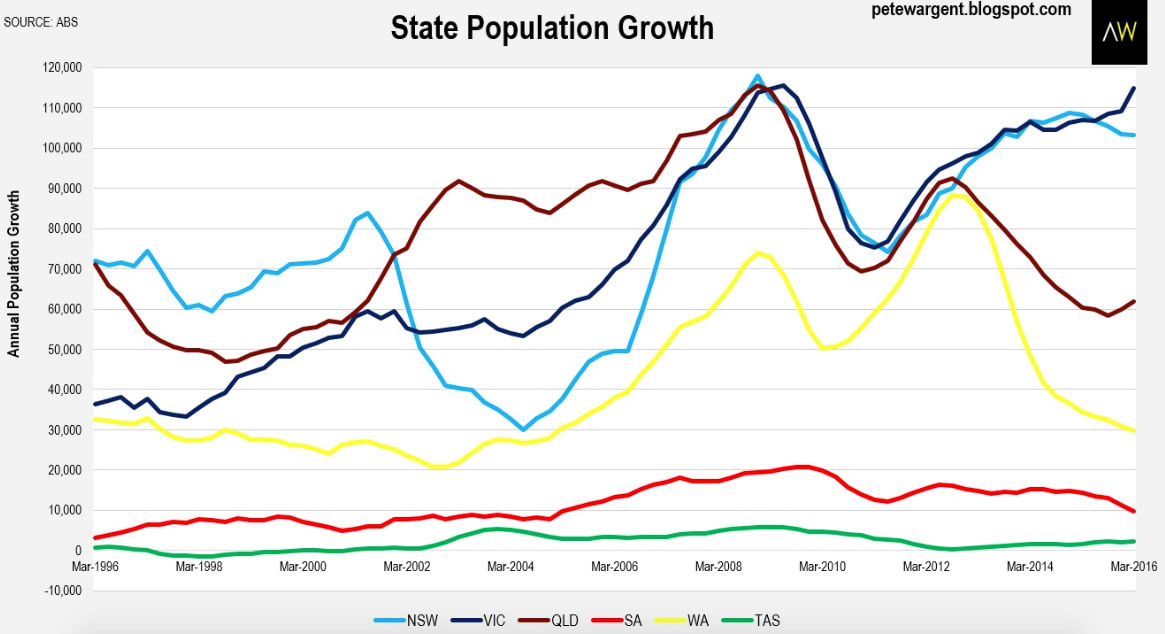There are still a great many property investors around in the market right now, so there shouldn't be too much upwards pressure on rents at the national level.
And, so it is!
The weighted average annual rents inflation across Australia's eight capital cities steadied at +0.7 per cent in the third quarter of calendar year 2016, according to the ABS Consumer Price Index figures.
As you can clearly see in the chart below, nominal rental prices at the national level only tend to spike dramatically when property investors are spooked out of the market for some reason, thereby stymying the available supply of rental stock.
This has only happened twice over the past 35 years or so, with the most recent trigger point being the global financial crisis.
However, with mortgage rates close to their record lows, there are presently oodles of investors in the domestic market - and many more from overseas too! - even in the face of recent curbs.

City by city
Of course, the outlook is as always quite different for each capital city, region, and sub-region.
I have presented a second chart below as an index to show what has happened to nominal rents over the last four-and-a-half decades.
One of the reasons I have done so is that although commentators seemingly love to spin out 'inflation-adjusted' results, the reality for many of us living today is that we often have 'rent versus buy' equations to weigh up, and for these decisions we understandably - and logically - tend to think in nominal terms.
"Are rents rising? Are dwelling prices rising? What about holding costs? Will mortgage rates increase or decrease? What is the smartest financial decision here?"
"Are rents rising? Are dwelling prices rising? What about holding costs? Will mortgage rates increase or decrease? What is the smartest financial decision here?"
In Sydney, annual rents inflation accelerated slightly to +2.5 per cent, which is still close to double the +1.3 per cent headline rate of inflation.
Blogsites and media do love a good falling rents meme, but this hasn't really been backed up by the facts, at least in Sydney's case.
Indeed, Sydney rents have increased at double the rate of inflation for nearly a decade now.
Since the beginning of 2007 Sydney's rental index has increased by +54 per cent, exactly double the rate of inflation for the harbour city over the same time horizon.
Rental growth may be softer than it was, and in fact it is already easing in some pockets of Sydney, but rents have hardly 'fallen' since the financial crisis as commentary sometimes tries to imply.
It's a very different Jackanory in the resources capitals, mind you.
After a great surge in both rents and dwelling prices through the heady days of the resources boom, the rental index numbers are in full on decline mode in Perth, falling back by -6.4 per cent over the year to September.
This puts the rental index for Perth back close to where it was at the peak of the mining boom four years ago in Q3 2012.
After a great surge in both rents and dwelling prices through the heady days of the resources boom, the rental index numbers are in full on decline mode in Perth, falling back by -6.4 per cent over the year to September.
This puts the rental index for Perth back close to where it was at the peak of the mining boom four years ago in Q3 2012.
And in Darwin, the equivalent year-on-year decline has been -7.7 per cent, although certain other metrics have implied that the real estate market in the Top End may be stabilising somewhat.

Rental growth is flat on this index in Canberra, while interestingly the rental growth index for Adelaide has by and large tracked that of Melbourne closely for almost the entire data series since 1972. You learn something new every day!
Supply response cavalry now arriving
The chart above hints at why Rory Robertson was always unlikely to lose his high profile 2008 bet cf. Sydney house prices correcting sharply.
While the annual rate of population growth in New South Wales rose incessantly from 2004 to 2008 up to an annualised peak of nearly 118,000, very little accommodation was actually being built, and this has resulted in nearly a chronic supply shortage and nearly a decade of strong rents growth.

What you don't need any charts to tell you - just listen to the jackhammers! - is that this dynamic has at last changed, with dwelling construction at now really hitting its straps over the last couple of years, and a veritable flood of apartment completions in the post.
---
In other news, Domain reported that Sydney's median house price rose by +2.7 per cent in the September quarter to a fresh all-time high of $1,068,000.
In Melbourne, the median house price rose by an even more sprightly +3.1 per cent over the quarter and +9.1 per cent over the year to also hit a record high of $774,000.
Somewhat surprisingly, median unit prices in Melbourne performed even more strongly again in the quarter in rising by +4.5 percent, to be +5.5 percent higher over the year.
Melbourne has been constructing dwellings like fury in recent years, but population growth has accelerated to extraordinarily high levels as you can see in the chart above.
---
In other news, Domain reported that Sydney's median house price rose by +2.7 per cent in the September quarter to a fresh all-time high of $1,068,000.
In Melbourne, the median house price rose by an even more sprightly +3.1 per cent over the quarter and +9.1 per cent over the year to also hit a record high of $774,000.
Somewhat surprisingly, median unit prices in Melbourne performed even more strongly again in the quarter in rising by +4.5 percent, to be +5.5 percent higher over the year.
Melbourne has been constructing dwellings like fury in recent years, but population growth has accelerated to extraordinarily high levels as you can see in the chart above.
PETE WARGENT is the co-founder of AllenWargent property buyers (London, Sydney) and a best-selling author and blogger.
His latest book is Four Green Houses and a Red Hotel.
